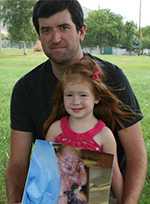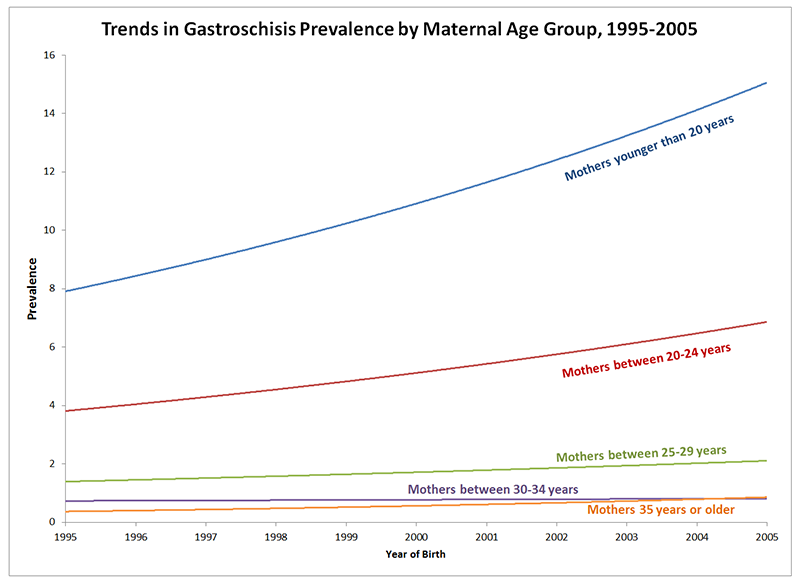Key Findings: Gastroschisis Increased from 1995-2005

Baby with gastroschisis
Obstetrics and Gynecology published a new study on gastroschisis, a birth defect where a baby’s intestines stick outside of the body through a hole beside the belly button. Previous studies from some individual states and other countries have suggested that gastroschisis has been on the rise in recent years. In this study, one of the largest in the United States, researchers with the National Birth Defects Prevention Network in collaboration with CDC found that gastroschisis increased from 1995-2005. You can read the article’s abstract here. Read more below for a summary of the findings from this article.
Main Findings from this Study
Researchers found that gastroschisis increased over time during the decade studied. These results are consistent with other studies.
- The prevalence of gastroschisis nearly doubled from 1995 to 2005. It increased from 2.3 per 10,000 live births in 1995 to 4.4 per 10,000 live births in 2005.
- Gastroschisis is more common
- among babies born to younger women than older women and
- among babies born to Non-Hispanic white women than among women of other racial/ethnic groups.
- The increase in the prevalence of gastroschisis has been mostly among teen mothers, who were more than seven times as likely to have a baby with gastroschisis compared to mothers 25-29 years of age. This increase in the prevalence of gastroschisis among teen mothers is not related to the birth rate for teen mothers, which actually declined.1
About this Study
Did You Know?
Although we don't know all the causes of birth defects, women can take steps before and during pregnancy to reduce the risk of having a baby born with birth defects. Such steps include taking a daily multivitamin with folic acid (400 micrograms), not smoking, and not drinking alcohol during pregnancy.
Family Stories
Read stories written by families affected by gastroschisis:

Researchers used data from population-based birth defects tracking programs in 15 states. Population-based means that the researchers look at all babies with birth defects who live in a defined study area, in order to get a complete picture of what is happening among all of the people (the population) living in the study area. Participating states were: Arizona, Arkansas, California (some counties), Colorado, Georgia (some counties), Iowa, Kentucky, New Mexico, New York, Oklahoma, North Carolina, Rhode Island, Texas, Utah, and Washington. In this study, researchers looked at the prevalence of pregnancies affected by gastroschisis born in these 15 states from 1995-2005.
Birth Defects: CDC’s Activities
CDC works to identify causes of birth defects, find opportunities to prevent them, and improve the health of those living with birth defects.
- Tracking: CDC tracks birth defects, like gastroschisis, through several state tracking systems and regional programs. CDC also supports and collaborates with the National Birth Defects Prevention Network (NBDPN), representatives from local, state, and national groups working on birth defects. For this study, researchers collaborated through the NBDPN to collect the data from the 15 different states.
- Research: CDC funds a large study of birth defects called the National Birth Defects Prevention Study. This study is working to identify things that increase the risk for families to have a baby with gastroschisis and many other birth defects. Results from the NBDPS teach researchers more about what might raise or lower the risk of having a baby with a birth defect.
More Information
For more information on birth defects, visit www.cdc.gov/birthdefects.
Key Findings Reference:
Kirby RS, Marshall J, Tanner JP, Salemi JL, Feldkamp ML, Marengo L, Meyer RE, Druschel CM, Rickard R, Kucik JE, for the National Birth Defects Prevention Network. Prevalence and correlates of gastroschisis in 15 U.S. states: 1995-2005. Obstet Gynecol. 2013 [epub ahead of print].
Other Reference:
- Page last reviewed: October 22, 2014
- Page last updated: October 22, 2014
- Content source:


 ShareCompartir
ShareCompartir
